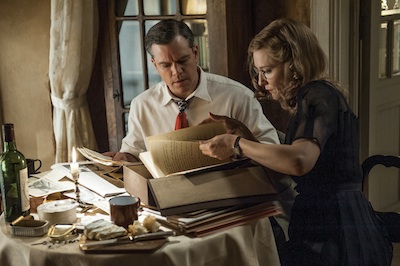By Michael Fox, Special to JTNews
When “The Monuments Men” was bumped from a prime December release date to this Friday, the company line was that co-writer-director-star George Clooney needed more time to properly finish the film.
Now that I’ve seen the movie, another explanation presents itself: Lacking dynamic characters and offering only occasional quivers of excitement, the World War II saga would have bombed at the box office against the high-powered year-end competition. Adding insult to injury, “The Monuments Men” almost certainly would have been pasted with the humiliation of zero Oscar nominations.
This is not to say the movie is without value, for it reminds mainstream viewers that the Nazis stole the treasures and possessions of Europe’s Jews—from paintings to gold teeth—with the same cold calculation that they murdered them.
Based on Robert M. Edsel’s 2009 book, “The Monuments Men: Allied Heroes, Nazi Thieves, and the Greatest Treasure Hunt in History,” the film lands a team of art experts in Europe after D-Day with the express mission of recapturing the immense horde of paintings and sculptures pilfered from museums, churches and private collections during the German occupation and subsequent retreat.
Frank Stokes (based on art historian George Stout and played by Clooney) has convinced President Roosevelt that, with victory assured, the goal of preserving civilization must shift to rescuing the world’s great artworks from certain destruction.
The seriousness of Stokes’ presentation contrasts with his jaunty, tongue-in-cheek recruitment of curators and art historians played by Matt Damon, Bill Murray, Bob Balaban, John Goodman, English actor Hugh Bonneville (of “Downton Abbey”) and Frenchman Jean Dujardin (Oscar winner for “The Artist”).
By the time the self-titled Monuments Men arrive in France in the summer of 1944, the Jewish victims of the Nazi campaign of murder and looting have long since been deported. Clooney makes a genuine effort to include and honor their off-screen suffering, providing the movie with one of its strongest moments.
Metropolitan Museum of Art curator James Granger (Damon) has made contact with a suspicious Parisian curator, Claire Simon (the splendid Cate Blanchett, delivering the film’s lone interesting performance). However, she’s convinced the American secretly intends to take any rescued French masterpieces back to New York with him.
Simon brings Granger to a warehouse crammed with boxes of personal effects, where he comes across a portrait that is plainly neither valuable nor important.
“What is all this stuff?” Granger asks. “People’s lives,” Simon replies. “What people?” “Jews.”
The next day, Granger visits an empty apartment and, seeing where a picture once hung, replaces the portrait. Simon, who has followed him, informs him the occupants won’t be coming back. In case we hadn’t already figured it out on our own, the word “Juden” is scrawled on the wall next to her.
“My job is to find and return art,” Granger says, standing in front of the portrait. “I figure I might as well start here.”
It’s a powerful image, even without the resonance of current battles over museum-held paintings that belong to the heirs of their Jewish owners.
From this moving high point, “The Monuments Men” descends into an awkward amalgam of tepid buddy comedy (with Murray and Balaban sleepily delivering lame banter), taut set piece and earnest treatise on the crucial legacy of art.
The dramatic requirements of movies, and the challenge of getting audiences to thrill to the exploits of art experts, compels Clooney to tilt his much-older-than-enlistment-age characters in the direction of semi-comic action heroes. The upshot is that “The Monuments Men” takes a softer, less satisfying road than such acerbic World War II escapades as “The Dirty Dozen” and “Kelly’s Heroes.”
For a truly great movie about saving European art, seek out “The Train,” John Frankenheimer’s 1964 drama about the French effort (driven by engineer Burt Lancaster) to stop a Nazi shipment of stolen paintings from getting to Germany.
